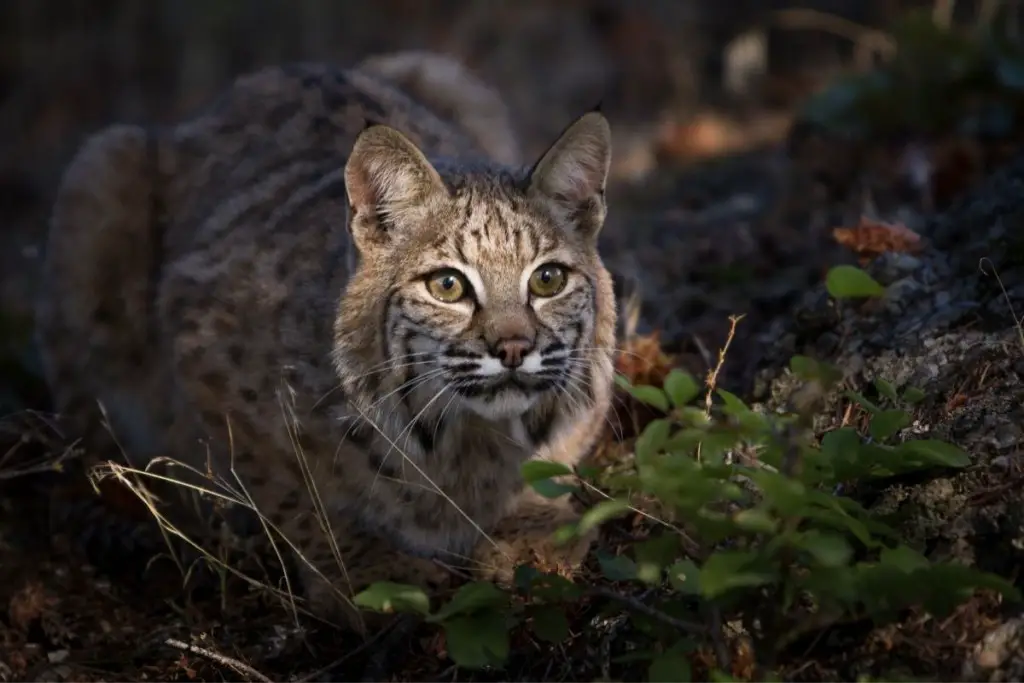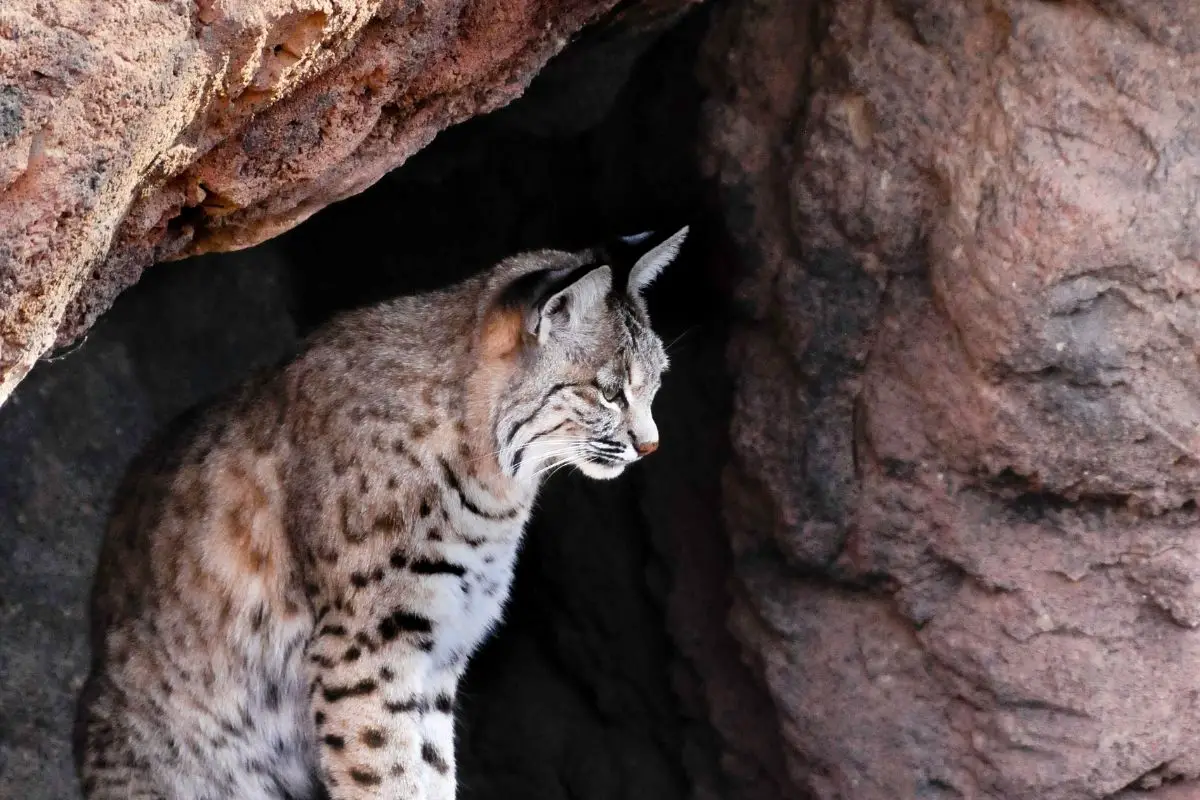I’ve been able to observe bobcats in their natural habitats, which gives me a unique perspective on how they pick where they live.
Understanding the habitat of a bobcat can be extremely important, especially if you have reason to believe that you may be near their den site or dwelling location.
Bobcats are known for being able to adapt to many different environments. This trait makes bobcats one of the most interesting and diverse animals in North America.
What Does a Bobcat Habitat Look Like?
Bobcats inhabit a diverse range of habitats across North America, including boreal forests, bottomland hardwood forests, coastal swamps, deserts, and scrublands. They prefer secluded spots for sleeping during the day, such as dense thickets, hollowed tree trunks, rocky outcroppings, burrows, and brush piles.
You should try to have a clear understanding of the type of habitats that bobcats are looking for because it’s important to know whether a bobcat may be roaming around your property’s region.
Bobcats have reportedly been a threat to many household pets and young children, especially during the late hours of the night. Bobcats are known for being nocturnal and crepuscular, revealing themselves at night and twilight to hunt for food.
Threats to Bobcat Habitats
Major threats to bobcat habitats include:
- Habitat loss and fragmentation from human development like housing, roads, pipelines, energy projects etc. This fragments their territory and prey base.
- Increased vehicle collisions as roads and traffic expand into bobcat habitats. Overpasses and underpasses can mitigate this.
- Climate change altering landscapes through drought, wildfires, flooding events etc. This can degrade habitats over time.
- Land use changes like deforestation, wetlands drainage, and converting natural areas for agriculture and livestock. Removes vital habitat cover and prey sources.
Conservation Status
- Bobcats remain abundant overall, but face localized declines:
- Endangered in Ohio due to overhunting and habitat loss. Reintroduction programs started in the 1960s and continue today.
- At risk in fragmenting habitats of Southeastern U.S. as development expands.
- Western populations generally remain stable with large intact habitats, but face some pressure from energy development projects.
Role of Habitat Corridors
- Preserving connectivity between isolated habitats via protected corridors is vital for bobcat population viability.
- Allows dispersal of juveniles to new territories to maintain genetic diversity.
- Provides escape routes from catastrophic events like wildfires.
- Allows range shifts with climate change. Fragmentation inhibits this.
Why Are Bobcats So Adaptable?
Bobcats are highly adaptable predators capable of thriving in a variety of habitats. They have an expansive range across North America, from forests and swamps to deserts and rocky canyons.
Bobcats can adjust their hunting techniques and diet to take advantage of the small mammal populations available in their home range.
They are excellent climbers who can hunt in trees or on the ground. Bobcats are also not dependent on water sources, enabling them to inhabit arid environments. Their adaptability allows bobcats to occupy diverse landscapes as long as there is adequate cover and prey.
This flexibility has contributed to the bobcat’s success across the continent.
One of the reasons that bobcats are among the most adaptable predators in the wild is because they can change the color of their fur coats to camouflage them from other animals.
In mountainous climates, bobcats can blend in with their surroundings by changing their fur color for the winter-like conditions. When bobcats leave colder climates, they will usually change their fur color to camouflage them once again for the new season.
In addition to their appearance changing depending on the region that they are in, bobcats are also able to live in very different regions because they can climb, jump, and hunt. They are equipped with sharp claws that are capable of attacking other predators in the wild.
Bobcats generally live a lifestyle that places them under the radar and they generally only hunt at night and in twilight hours.
The adaptable lifestyle that they are capable of living is truly fascinating and it’s one of the reasons that bobcats can be so threatening to other animals and even humans in some cases.
See our article for How To Identify a Bobcat
Where Do Bobcats Make Their Homes?
Wild animals such as bobcats tend to make their homes in habitats that provide them with forests, heavy brush and scrubland, areas with caves, and more. Depending on what type of region a bobcat is in, they may make their homes in a cave, such as in mountains and semi-desert regions.
In swamp areas, they may find a tree stump that is hollowed out or have a den dug underneath a pile of wood or fallen trees. They are great at finding areas where they blend in. Bobcats are solitary and prefer to be left alone.
| Habitat | Description |
|---|---|
| Forests | Bobcats thrive in mixed deciduous-coniferous forests with dense undergrowth. They hunt squirrels, rabbits and other small mammals while using logs, stumps and rocky outcroppings as cover and den sites. |
| Swamps | Swampy, flooded forests and wetlands provide habitat for bobcats to prey on birds, frogs, and slow-moving turtles while using tree trunks and dense thickets for stalking. |
| Deserts | In rocky and sandy deserts, bobcats hunt rabbits, ground squirrels, prairie dogs, and other small mammals while taking shelter in rocky crevices and dens. |
| Brushlands | Overgrown fields, scrublands, and brushy ravines with thick vegetation are ideal habitat, providing cover for bobcats to ambush rabbits, mice and other prey. |
| Canyons | Rocky canyons with crevices, caves and ledges provide den sites and hunting perches for bobcats to take small mammals like rock squirrels, chipmunks and birds. |
| Suburban areas | Bobcats inhabit preserves and parklands near suburbs, hunting mice, squirrels and rabbits while denning in brushy ravines and taking shelter under sheds. |
Where Do Bobcats Sleep?
Bobcats are mostly nocturnal, which means they usually sleep during the daytime hours in their dens and come out to hunt at night. All bobcats take their ‘territory’ very seriously and it can be rare for them to overlap the territory of another bobcat except for breeding.
They can sleep in caves, trees, and other disguised locations in the wild. They are not commonly seen moving around in the daytime. It can happen in some rare instances but most of their hunting will take place at night.
Bobcats can roam around their home territory and move several miles every single day. They will generally take actions throughout their territory to prevent other bobcats from claiming it from them.
Bobcats need to use their abilities to their advantage so that they can find a safe place to sleep before going out to hunt for food at night. They are not afraid of climbing up to challenging locations if it means that they might be able to rest in a cave on the side of a mountain.
The choice of sleeping habitat often depends on factors such as availability, climate, and the presence of potential predators. Regardless of the specific location, bobcats exhibit a preference for spots that afford them protection from adverse weather conditions and minimize their risk of detection by potential threats.
These elusive felines are known for their solitary nature and stealthy behavior, making their selection of sleeping habitat an integral part of their survival strategy in the wild.
Can Bobcats Live in Snowy Conditions?
You might not find a whole lot of bobcats in regions that get a lot of snow in the wintertime. Bobcats are not particularly fond of snowy climates, and they generally try to stay away from them as much as possible. Bobcats are known for preferring a habitat with warmer conditions. Deserts, forests, and swamps are all regions that bobcats would prefer to live in before they’d choose to live in a snowy mountainous region.
That doesn’t necessarily mean that they would struggle to survive in snowy conditions. They would certainly not be as comfortable living in a biome that receives severe winter weather.
See more information on bobcat territory in our article Where Do Bobcats Live?
If they do choose to roam around in snowy regions, they are capable of adjusting their fur color to blend in with the environment. This is an extremely important ability that bobcats have that can be used to hide from predators.
What Do Bobcats Eat in Different Habitats
A bobcat’s diet can vary depending on the habitat and prey availability in its home range. Bobcats are opportunistic predators that will eat a wide variety of small animals.
In forested areas, bobcats primarily hunt small mammals like squirrels, chipmunks, mice, voles, and rabbits. They use their keen sight and hearing to ambush prey from logs, rocky outcroppings, or thickets. Deer fawns and small birds may also be taken when available.
In swampy wetland habitats, bobcats take advantage of the abundance of waterfowl, eating ducks, geese, herons, and other aquatic birds. Slow-moving turtles and lizards are also bobcat prey when caught out in the open.
In rocky deserts and canyons, bobcats rely heavily on rock squirrels, ground squirrels, prairie dogs, and gophers that live among the rocky crevices and shrubs. Smaller rodents like mice and voles are hunted along with the occasional snake or lizard.
Near suburban areas, bobcats take rabbits, rats, mice, and squirrels that live in adjacent wild spaces. Pets like cats and small dogs may also be preyed upon where residential areas encroach on bobcat habitat.
Across all habitats, bobcats are drawn to areas with high populations of their main prey – small mammals like rabbits, hares, squirrels, rats and mice.
They are opportunistic in expanding their diet to take advantage of whatever small animals are abundant in their home range. A flexible diet enables bobcats to thrive across diverse habitats.
Bobcat Habitat Facts
Bobcats are native to North America. You can find bobcats in southern Canada, Most of the United States, and parts of Mexico. They are widespread due to their skills to adapt and stay alive. North America is their Territory.
They mark their territory. Bobcats will mark their territory with scent and other forms of communication. A female will mark her den with urine and other signs, to let other bobcats know she is using the den as a natal den, for her kittens.
Bobcats prefer biomes where there are a lot of woods, such as forests and mountain areas. however, they have been able to adapt to many other conditions, such as living in urban environments and even being kept as pets.

Conclusion
Bobcats are fascinating animals and their ability to adapt in the wilderness should not be underestimated. They have an impressive population across North America and are currently expanding their species’ numbers. Source.
They live in a variety of habitats and have a collection of abilities that make them extremely capable hunters.
Bobcats are known for eating rabbits and birds primarily, although they do occasionally eat other small animals such as rodents if the opportunity presents itself. They are not usually considered a threat to humans, but they can be extremely dangerous to younger children or household pets.
See our article for Are Bobcats Dangerous?
It’s important to know if you live adjacent to a bobcat habitat. You shouldn’t be intimidated by these animals but you should take some steps to protect your pets and property if you determine that they live nearby your house.
Have you ever seen a bobcat in the wilderness? Tell us about it in the comments below!
- Hero Farm Dog Survives Epic Battle with Coyote Pack - December 9, 2024
- The 10-Minute Bedtime Routine That Changed My Dog’s Sleep Forever - November 29, 2024
- Creating a Safe Space for Nervous Pets: Your Guide to Pet-Friendly Havens - November 25, 2024

